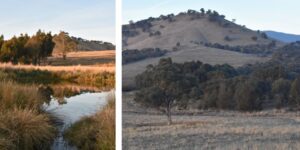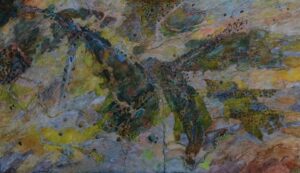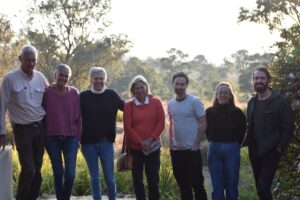At Bibbaringa, Gill Sanbrook shows how healthy rivers, land and communities can thrive together.
When Gill Sanbrook first moved to Bibbaringa in 2007, the land and soil had suffered from years of overgrazing. “It was just dirt,” Gill explains. “It had been totally overgrazed.”
As we stand atop a hill on her property, overlooking native grasses, a loud flock of cockatoos and thousands of gumtrees snaking along the valleys, it’s hard to believe it’s the same place.
Gill’s approach to farming is both regenerative and holistic. It’s a mindset that means actively caring for and improving the health of the land, rather than just exploiting it for profit. “I use the word ‘hum’. I want to be able to feel this place sing,” Gill says.
Bibbaringa is a 950-hectare cattle farm north of Albury. It’s in the southwest slopes of southern NSW, adjacent to the Murray River. Nearby, snowmelt from the Southern Alps of NSW and Victoria feed the Murray as it begins its journey out to SA.
When Gill moved to the property, she started with rebuilding the soil biology and restoring native grasses to help keep groundcover throughout the year. Gill uses a method called planned rotational grazing, which involves rotating cattle through more than 100 temporary paddocks. This method gives each paddock time to recover in between grazing, while also helping nourish the soil and encourage diverse, native perennial grasses like kangaroo grass to grow back. Gill’s friend and fellow regenerative farmer Jill Coghlan describes these grasses as a “salad bar for cattle” at her farm.
Gill’s next focus was to rehydrate the landscape, thinking about the river as a natural, shifting body of water rather than an irrigation channel or a drain. “What I’m trying to do is slow the water down and get it to cut out of the channel and into the landscape and former floodplain,” she explains.

She’s done this by building contours in the ground that snake out from the creek and carry water to chains of ponds and dams, filled with native plants like cumbungi bullrushes. Gill has also planted more than 70,000 trees and shrubs across the property.
As we drive along, she points to a body of water on her right. “This is the wetland I didn’t know was going to happen,” she laughs. As water began to flow and settle more naturally on the property, the wetland re-appeared. Now, it’s full of phragmite reeds, sedges and rushes, and provides a home for frogs and waterbirds like herons and ducks.
All too often, water in the Murray-Darling is framed as a resource that needs to be transported from point A to B. Gill’s holistic approach provides an alternative – showing how we can support both healthy farms and nature by restoring natural flows, rehydrating the landscape and building biodiversity and natural capital on farmed landscapes.
Driving around Gill’s property, it’s easy to see the “mosaic patterns and symmetry of the farmed landscape” that inspired the Earth Canvas project. The idea behind it was to “celebrate the landscape through the arts,” by pairing 6 artists with 6 regenerative farm families located between the Murray and the Murrumbidgee rivers in southern NSW.

John Wolselely, Chains of ponds, contour banks and the return of the reed warbler, Bibbaringa 1, 2019-20
These farmers had come together back in 2008 through a shared passion for regenerative farming. They decided to form a group called 8 Families to help share their experiences and lessons and show others the benefits of regenerative farming. The group believe there is huge potential to challenge the dominance of industrial farming in Australia with more funding and training opportunities for farmers to learn more.
For the Earth Canvas project, each artist was asked to create a body of works to express their experience of a regenerative farm. As Gill explains, they hoped it would “encourage land managers and food consumers and agencies to see the landscape in a more empathetic way, and thereby help to create a healthier world.” The art project reached thousands of people, with open days at each farm and a travelling exhibition that culminated at the National Museum of Australia.
It’s clear Gill’s passion for caring for the land is mirrored in her passion for creating and bridging connections among the wider community. It embodies so much of her holistic management approach, showing how healthy rivers, land and communities need each other to thrive.

Learn more:
Bibbaringa > https://www.bibbaringa.com/
Earth Canvas > https://earthcanvas.com.au/
8 Families > https://www.8families.com/